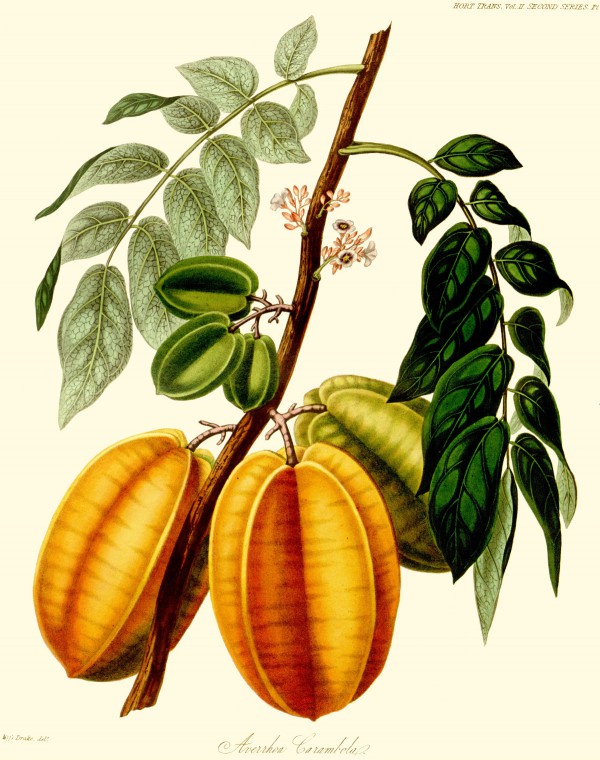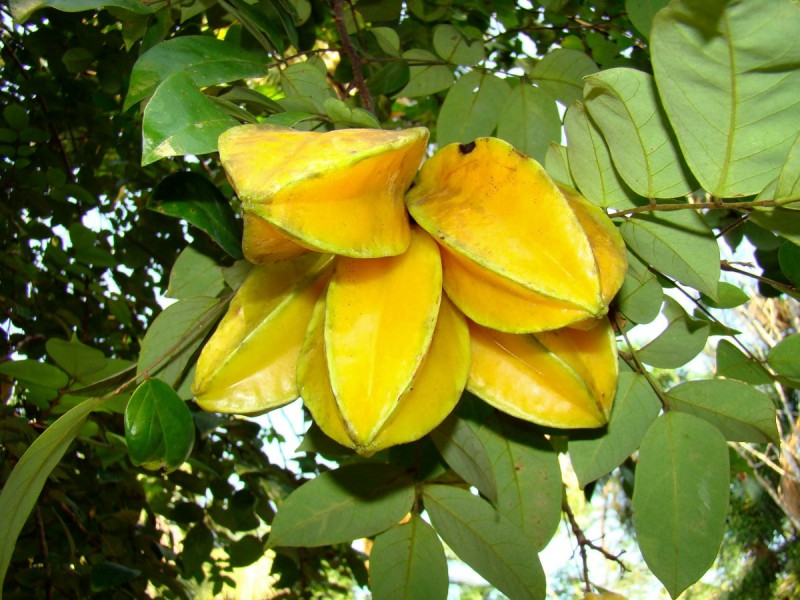Averrhoa carambola L. - syn. Averrhoa pentandra Blanco - Oxalidaceae - carambola, star fruit, Karambole, Sternfrucht
Small evergreen tropical tree or shrub, 3-5 (-10)m high, possible origin Java, cultivated for fruit; leaves alternate, pinnate, 15-25cm long, shortly petiolate, leaflets 7-9, sensitive to touch like certain Mimosa species; inflorescences panicles 2-5cm long, in the axils of old leaves; flower with a calyx of 5 pink sepals surrounding the purple corolla; fruit a large berry, 5-8cm long, characteristic star shape in cross-section, yellowish-green, orange-yellow when ripe; each fruit cell with 5 seeds.
„Heterostyly and self-incompatibility occur in A. carambola. Pollen grains are elongated or spherical; a suitable pollen viability test would be in vitro pollen germination. A. carambola is insect pollinated, the pollinators being honeybees and Diptera species. Flowering continues throughout the year and fruit is available most of the year. Seedling varieties should crop in 3-8 years, selected grafted varieties in only 1-2 years.“
http://www.worldagroforestry.org/treedb/AFTPDFS/Averrhoa_carambola.PDF
„Averrhoa carambola has a number of different forms differing in fruit taste, texture, and shape, some are very acidic and others are sweet.“
https://en.wikipedia.org/wiki/Averrhoa_carambola
„There are 2 distinct classes of carambola - the smaller, very sour type, richly flavored, with more oxalic acid; the larger, so-called „sweet“ type, mild-flavored, rather bland, with less oxalic acid…
In 1975, 16 carambola selections and 2 named cultivars were assayed at the United States Citrus and Subtropical Products Laboratory, Winter Haven, Florida. Preliminary taste tests ranked 'No. 17, 'No. 37', 'No. 42' and 'Tean Ma' as preferred. In a later test, 'Dah Pon' was ranked above 'Tean Ma'. 'No. 17' (º Brix 9.9) was described as „sweet, good and apple-like“. 'No. 37' (º Brix 6.7), as „sour and sweet“. 'No. 42' (º Brix 8.3), as „sour, tart and apple-like“. 'Dah Pon' (º Brix 8.0), as „good and mild“. 'Tean Ma (º Brix 7.2), as „sweet, good and mild“. Analyses showed that these 5 were among those with relatively high ascorbic acid content-'No. 17, 30 mg; 'Dah Pon', 30 mg; 'No. 37', 37 mg; 'No. 42', 37 mg; and 'Tean Ma', 41 mg. 'No. 40' had 43 mg and 'No. 11', 50 mg, whereas 'M-23007' had only 14 mg and 'No. 10' only 17 mg.“
[Morton, Julia Frances. Fruits of warm climates. JF Morton, 1987, 125-128] https://hort.purdue.edu/newcrop/morton/carambola.html
An aroma extract prepared from stored fruits was described as sweet, estery and fruity (peach/apricot/plum-like). Quantitatively, the most abundant components were hydrocarbons like tricose-1-ene (21.4%) and pentacose-1-ene (10.3%) and acids like linoleic acid (15.5%) and palmitic acid (12.3%). 57 esters accounted for 9.0%, providing fruiy shades. Methyl N-methyl anthranilate (2.4%), methyl anthranilate (0.7%), and ethyl N-methyl anthranilate (0.2%) provide grape-like notes. As the odor of starfruit is described as peach/apricot/plum-like, γ-lactones (peach-like, C10 0.4%, C11 0.05%, C12 1.8%) and δ-lactones (apricot-like, C11 trace, C12 0.07%, C13 1.5%) are sensory important. Very potent odorants are carotenoid degradation products, a number of them were identified: geranyl acetone (0.3%), β-ionone (0.8%), β-damascenone (0.02%), (E)- and (Z)-dehydro-β-ionone (0.1%, trace), β-ionol (0.9%), and 4-hydroxy-β-iononl (0.05%), as well as some interesting megastigma-4,6,8-trienes (rose-raspberry?, E,E 0.3%, E,Z 0.2%, Z,E 0.9%, Z,Z 0.07%) and oxo-derivatives like megastigma-5,8(E)-dien-4-one (0.3%) and megastigma-5,8(Z)-dien-4-one (0.1%).
[Volatile components of starfruit., MacLeod, G., Ames, J.M., Phytochemistry, 29(1), 1990, 165-172]
„Earlier, it has been considered to be a sour-tasting fruit with a relatively high oxalic acid content and consequently of little commercial value for consumption as fresh fruit. New, sweet-flavoured cultivars with a low oxalic acid content are rapidly defying the old notion. The unique (five cornered) star like shape and sweet taste have a strong appeal and liked by many.“
[Ray, P.K. (2002), Breeding tropical and subtropical fruits, New Delhi: Narosa Pub. Pub. House, 307-309]
„The starfruit neurotoxin caramboxin is metabolized and excreted by the kidneys. In healthy individuals caromboxin is readily flushed from the body, but in compromised individuals with renal disease or failure, it accumulates and signs of neurotoxicity, such as the dreaded hiccups, begins. I’ve seen starfruit consumption discouraged, or forbidden, for those with kidney failure or on dialysis, but not nearly frequently enough… consumption of large amounts of starfruit induces oxalate crystal nephropathology and acute renal failure (or exacerbates an existing disorder), preventing the clearance of caramboxin, leading to neurotoxicity in the form of hiccups. Once renal dysfunction clears up, the hiccups go away.“
Aqueous solutions of caramboxin lose their biological activity after a few hours. Caramboxin undergoes an intramolecular cyclization (condensation) to an inactive compound.
https://naturespoisons.com/2015/10/01/starfruit-which-came-first-the-hiccups-or-the-kidney-failure-caramboxin/
[Neto, M. M., da Costa, J. A. C., Garcia‐Cairasco, N., Netto, J. C., Nakagawa, B., & Dantas, M. (2003). Intoxication by star fruit (Averrhoa carambola) in 32 uraemic patients: treatment and outcome. Nephrology Dialysis Transplantation, 18(1), 120-125] https://academic.oup.com/ndt/article/18/1/120/1809123/Intoxication-by-star-fruit-Averrhoa-carambola-in
[Garcia‐Cairasco, N., Moyses‐Neto, M., Del Vecchio, F., Oliveira, J. A., dos Santos, F. L., Castro, O. W., … & Dagostin, A. L. (2013). Elucidating the neurotoxicity of the star fruit. Angewandte Chemie International Edition, 52(49), 13067-13070]

Averrhoa carambola L., Transactions of the royal horticultural society of London, 2nd Series, vol.2 t.2 (1842) [S.A.Drake]
http://plantgenera.org/species.php?id_species=121174

Averrhoa carambola L., Specimen Huamán, M.-281, Copyright MBG CC BY-SA 3.0
http://www.tropicos.org/Image/100465473